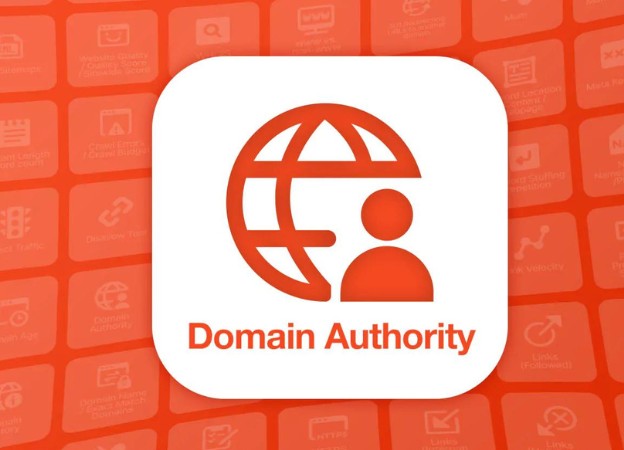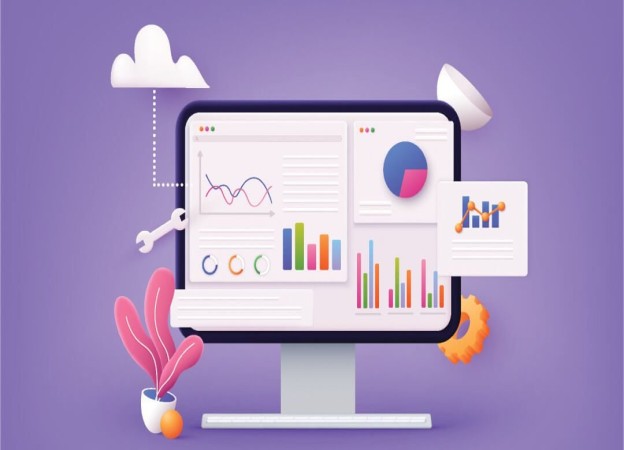What constitutes domain authority?
Domain authority is a complex issue that is influenced by many factors. Although the exact search engine algorithm remains a mystery, we can point out a few key elements that play an important role in building a website's authority. Let's take a closer look at these components, because each of these elements requires a separate discussion and implementation strategy.

In the following sections, we'll take a closer look at each of them to better understand how we can effectively build our domain authority.
Thematic coverage of key phrases
Thematic coverage of key phrases is a key element in building domain authority. It refers to the breadth and depth with which a website covers a particular topic or field. Search engines such as Google value sites that provide comprehensive and valuable information on a given topic.
To achieve good topic coverage, you should create content that not only focuses on your main keyword phrases but also includes related terms and topics. The idea is to create a kind of "content ecosystem" where various articles and subpages complement each other and create a coherent whole.
Effective thematic coverage requires a thorough understanding of user needs and intentions. You should answer questions that potential visitors may have about your topic and provide them with comprehensive answers. This approach not only helps with SEO, but also builds users' trust in the website as a reliable source of information. It is also important that the content is current and updated regularly. Search engines prefer websites that provide the freshest and most up-to-date information on a given topic. Therefore, it is worth regularly reviewing and refreshing existing content, adding new information and removing outdated information.
Thematic coverage, however, does not mean forcing a huge amount of content. Quality should always trump quantity. It's better to have fewer, but in-depth and valuable articles than a lot of superficial content that brings no real value to the user. Finally, good thematic coverage should take into account various content formats - not only text, but also graphics, videos and infographics.
A variety of forms of information presentation can help better meet the needs of different user groups, as well as increase the attractiveness and usability of the website.
Page structure
Page structure is a fundamental element in building domain authority, acting as the framework on which a website's entire online presence is based. A well-designed structure not only facilitates user navigation, but also helps search engine robots (e.g. Google Bot) to effectively index and understand the content of the page.
A key aspect of proper structure is logical hierarchy. The home page should be a starting point from which users can easily navigate to more detailed subpages and categories. The navigation menu is also an important element of the structure. It should be transparent, easy to use and consistent on all subpages. A well-designed menu helps users quickly find the information they are looking for, which translates into a better user experience and longer time spent on the website.
The role of the sitemap in the context of the structure cannot be ignored. A sitemap not only helps users navigate, but is also a valuable tool for search engine robots, helping them understand the organization of content on the site. The page structure should also include the appropriate use of headings (H1, H2, H3, etc.). Correct heading hierarchy not only improves the readability of your content for users, but also helps search engines understand the relationships between different sections of the page.
It is worth remembering the so-called "flat architecture", where each subpage is available in a maximum of three clicks from the main page. This structure facilitates indexing and transfer of "link juice" between subpages. A well-designed website structure not only improves usability for visitors, but also significantly affects how search engines perceive your website, helping to build strong domain authority.
Content quality
Content quality is a fundamental element in building domain authority, constituting a kind of currency in the world of search engines. High-quality, valuable content is the key to attracting and retaining users' attention, as well as gaining recognition in the eyes of search engine algorithms.

First of all, quality content should be unique and original. Search engines value websites that provide a new, fresh perspective on a given issue and do not duplicate information already available on the Internet. Original content not only helps avoid duplication problems, but also builds the website's reputation as a reliable source of information.
An important aspect of content quality is its usefulness to the user. The content should respond to the real needs and questions of the recipients, providing specific, practical information or solutions. The more helpful the content is and solves users' problems, the higher it is rated by both readers and search engines.
Accuracy and timeliness of information are other key elements of quality content. Websites that regularly update their content and ensure that they present the latest, verified information gain greater user trust and a better position in search results.
The importance of readability and text structure cannot be ignored. Well-formatted content, with appropriate use of headings, paragraphs, lists and other formatting elements, not only makes it easier to read, but also helps search engines understand the hierarchy and meaning of individual pieces of text. It is worth remembering about multimedia - high-quality photos, infographics and videos not only make the content more attractive, but also help to convey information better, which translates into longer time spent on the website and a lower bounce rate. The length of the content also matters, although there is no one universal rule.
The content should be extensive enough to comprehensively discuss a given topic, but at the same time concise and free from unnecessary digressions. Search engines often favor longer, more in-depth articles, but only if each piece of text brings real value. Finally, the quality of content also means adapting it to the target group.
The language, style and level of detail should meet the expectations and needs of a specific audience, which translates into greater user involvement and longer time spent on the website. Creating high-quality, useful content takes time and effort, but it is an investment that brings tangible benefits in the long run in the form of higher domain authority, better positions in search results and user loyalty.
External linking
External linking, i.e. backlinks leading to our website from other websites, is one of the key factors influencing the domain authority. They can be compared to recommendations or votes of confidence in the online world.
The more high-quality sites link to our site, the more authority we gain in the eyes of search engines. The quality of incoming links is definitely more important than their quantity. A link from a reputable, topically related site with high authority can be much more valuable than hundreds of links from irrelevant or low-quality sources.
Search engines like Google are becoming more sophisticated in assessing link quality and able to recognize manipulation attempts. The variety of link sources also plays an important role. Natural link profiles include links from various types of websites - blogs, news portals, forums, industry websites and social media.
Such diversity proves the authenticity and versatility of our website. The context in which a link appears is important. Links embedded in editorial content that naturally fit the context of the article are more valuable than those placed in footers or link lists. Search engines analyze the text surrounding a link to better understand its relevance.
Anchor text, i.e. the text of the link, also affects the linking value. Diverse, natural anchor texts are preferred by search engines. Excessive use of exact keywords as anchor texts may be perceived as an attempt to manipulate search results. The rate of link acquisition should be natural and organic. A sudden increase in the number of links can make search engines suspicious and potentially lead to penalties.
Stable, gradual increase in links (link building) is perceived as more credible. It is worth remembering that external linking works both ways. Linking to valuable, authoritative external sources can also positively impact the perception of our site by search engines and users. Monitoring your link profile is crucial.
Regularly analyzing incoming links allows you to identify potentially harmful links and take appropriate actions, such as disavow (rejecting) unwanted links. External linking is a powerful tool in building domain authority, but it requires a strategic and ethical approach. Focusing on acquiring natural, high-quality links from credible sources is the key to long-term SEO success and building a strong position in search results.
Internal linking
Internal linking, although often underestimated, is a key element in building domain authority. It involves creating connections between various pages and subpages within one website. It is a tool that not only helps users navigate, but also plays an important role in search engine optimization.
First of all, internal linking helps distribute link juice throughout the site. This transfers the importance and authority of your home page and other strong pages to less popular parts of your site, which can improve their ranking in search results.
The internal linking structure should reflect the logical hierarchy of content on the page. Top pages and categories should be linked to more often, which signals to search engines their importance in the overall structure of the site. Anchor texts in internal links are as important as in external links.
They should be descriptive and contain important keywords, but at the same time remain natural and useful to the reader. Avoid generic phrases like "click here" in favor of more contextual descriptions. Strategic internal linking can help promote new or less popular content. By linking to them from popular websites, we can increase their visibility both for users and search engine robots.
It is worth remembering the "three-clicks" rule - each page on the website should be accessible within a maximum of three clicks from the home page. This structure makes it easier for search engine robots to index and crawl the page. Contextual linking, i.e. placing links in the content of articles, is particularly valuable. Such links are more natural and useful for the reader than those placed in the navigation menu or website footer. Avoid excessive internal linking.
Too many links on one page may be perceived as spam and negatively impact the user experience and the site's rating by search engines. Regularly analyzing and updating your internal linking structure is crucial. As your site grows and evolves, you should adjust your linking strategy to reflect your current content structure and priorities. It is worth using analytical tools to monitor the effectiveness of internal linking. This will allow you to identify pages that may require additional linking support and optimize the entire structure.
A well-thought-out internal linking strategy is a powerful tool in building domain authority. It helps in better page indexing, improves navigation for users, and effectively distributes SEO value between different parts of the site. This is one of the elements of website positioning over which we have full control, so it is worth paying due attention to it.
Lack of technical problems
The lack of technical problems, especially those related to indexing, is a key element in building domain authority. Even the best content and linking strategy will not bring the expected results if the website struggles with technical obstacles that prevent it from functioning properly and being indexed.
First of all, you need to ensure the correct configuration of the robots.txt file. This inconspicuous file is of great importance because it tells search engine robots which parts of your site can be indexed and which should be omitted. Incorrect configuration may lead to important pages not being indexed or, conversely, content that should remain hidden being indexed. Sitemap.xml is another key element.
A well-constructed sitemap makes it easier for search engine robots to find and index all important subpages. Regularly updating sitemap.xml, especially when new content is added, is essential for effective indexing. Page loading speed has a significant impact on both user experience and indexing. Slowly loading pages may be skipped by search engine robots, which negatively affects indexation and ranking.
Image optimization, CSS and JavaScript minification, and cache utilization are key steps in improving speed. Responsiveness and a mobile version of the website are essential in the era of mobile-first indexing.
Google prioritizes mobile versions of websites, so you need to make sure your website is fully functional and easy to navigate on mobile devices. Content duplication issues can significantly impact indexing and domain authority.
Correct use of canonical URLs (rel=”canonical”) helps avoid duplication problems and indicates to search engines the preferred version of the page to index. 404 (page not found) errors should be minimized. Regularly monitoring and fixing broken links and proper (301) redirects for deleted pages are crucial to maintaining good indexing hygiene.
Website security, including the use of the HTTPS protocol, is not only important for users, but also affects the website's rating by search engines. Unsecured pages may be given less priority for indexing. Correct implementation of meta tags, including title and description, helps search engines understand the content of the page and index it appropriately. Unique and descriptive meta tags for each page are crucial. The URL structure should be logical and friendly to both users and search engines. Readable, short URLs containing keywords facilitate indexing and improve your overall page rating. Regular SEO audits are essential to detect and resolve potential issues before they negatively impact your website's indexing and ranking.
Using tools such as Google Search Console can help identify and resolve indexing issues. Ensuring the technical efficiency of the website, especially in aspects related to indexing, is the foundation of building strong domain authority. Regular monitoring and solving technical problems not only improves the website's visibility in search results, but also contributes to a better user experience, which in the long run translates into higher authority and better positions in the SERPs.



